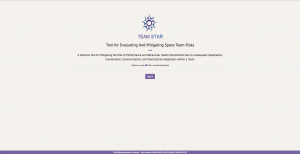BACKGROUND
Long distance missions like those envisioned to explore Mars, will be one of the most challenging and complex human endeavors of all time. One important factor determining the success or failure of these missions will be teamwork. Crews will live and work together in harsh and uncertain conditions for extended periods of time. NASA is currently developing a variety of countermeasures to support crew functioning. We present the development of a dashboard designed to leverage the results of multiple findings and countermeasures relating to team risk, into a single crew support tool. TEAMSTAR is currently using three computational models, predicting crew cohesion, crew shared mental models, and crew performance, all of which were validated based on data in the Human Exploration Research Analog.
METHOD
TEAMSTAR was developed using computational models from three active NASA projects (NNX15AM32G, NNX15AM26G, NNX15AK73G). Each of the models operationalized relevant theories of team functioning into a formalized computational model. Next, observations on all variables included in all three models were collected in NASA’s HERA. Model parameters were estimated based on analog data using BehaviorSearch [2], a genetic algorithm in the NetLogo agent-based modeling software [3]. Lastly, we integrated these models and their resulting recommendations into a web-based software interface that allows mission support and/or crew members to directly assess the current and future health of a crew, make informed decisions about crew membership and assignments, and receive mitigation strategies.
TEAMSTAR
The Tool for Evaluating and Mitigating Space Team Risk (TEAMSTAR) is a software interface that assists mission planning and support through two primary modes of evaluation: pre-launch and post-launch. In pre-launch mode, mission planners draw directly from a pool of crew candidates and possible mission schedules to identify optimal combinations of the two. Specifically, the dashboard provides mission planners information on the crew’s predicted performance across a given mission schedule based on their cohesiveness as a crew, the strength of their shared mental models, and their tendency to switch tasks. This allows mission planners to have a more informed picture of how decisions about the crew and mission schedule will affect the success and health of the crew, especially in the long-term. In the post-launch mode, mission support receive information on the current state of the crew in terms of cohesiveness, shared mental models, and task switching effectiveness along with associated challenges. They also receive projected forecasts, and accompanying potential challenges, based on the upcoming mission schedule. Identification of these challenges allows mission support to better understand both how to maintain high crew performance and how to intervene with an at-risk crew. Further, the post-launch mode allows mission support to explore how changes to the schedule will impact crew performance over both the short- and long-term. Critically, use of these features requires data be uploaded into TEAMSTAR. These include data about individual characteristics of the crew, crew relationships, attributes about the tasks and tools at hand, and the overall mission schedule. These data are used by the agent-based computational models to generate concise reports, forecasts and recommendations to mission planning and mission support via an easy-to-use interface. All of the analytics provided by these agent-based models have been developed in NASA projects, and validated using data collected through HERA.
Visit the website: TEAMSTAR

Investigators:
Noshir Contractor, Leslie DeChurch
Developers: Anup Sawant, Harshad Gado
